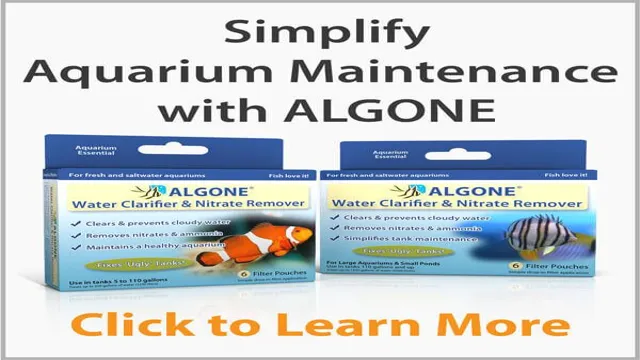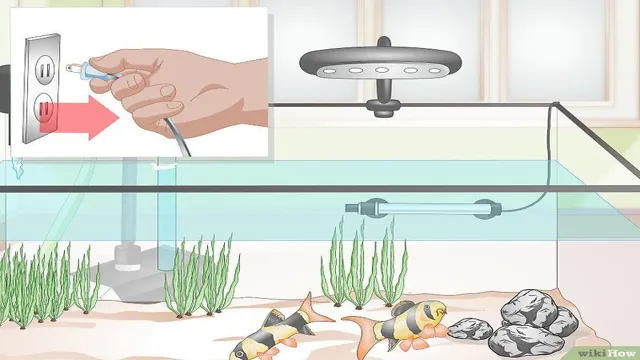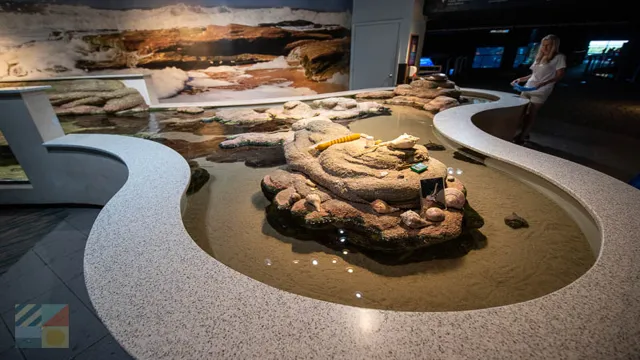Maintaining a large aquarium can be a challenging but rewarding experience for any fish enthusiast. However, keeping your aquarium clean can be quite a hassle. Fish produce waste, which can accumulate quickly and lead to poor water quality, and even death of your aquatic pets.
In this blog post, we’re going to provide you with some tips and tricks to keeping your large aquarium sparkling clean. From proper filtration techniques to regular water changes, we’ve got you covered. So, if you’re looking to take the first step in ensuring the health and happiness of your aquatic friends, read on!
Choosing the Right Filtration System
Keeping a large aquarium clean can be a daunting task, especially if you don’t have the right filtration system in place. When choosing a filtration system for your aquarium, it is essential to consider the size of your tank and the type of fish you have. A high-quality filtration system should remove all the harmful waste and debris from your aquarium, creating a clean and clear environment for your fish to thrive in.
You can choose from three types of filtration systems: mechanical, biological, and chemical. Mechanical filtration systems remove all the debris and waste accumulated in the aquarium. Biological filtration systems rely on bacteria to break down harmful waste and convert it into less toxic byproducts.
Chemical filtration systems use activated carbon to remove impurities and odors from the water. Ideally, you should choose a filtration system that incorporates all three types for optimal aquarium health. By choosing the right filtration system, you can ensure your fish live in a healthy and thriving environment.
Assessing Your Needs
When it comes to choosing the right filtration system, it’s important to assess your needs. Are you looking to filter drinking water? Or perhaps you need to filter water for a large industrial process. Knowing your specific needs will help you narrow down your options and find the best system for you.
It’s also important to consider factors such as the frequency of use, the type of contaminants you need to remove, and the overall cost of the system. By carefully evaluating your needs, you can ensure that you choose a filtration system that will effectively and efficiently meet your requirements. So if you’re in the market for a filtration system, take the time to assess your needs and make an informed decision that will provide clean water for years to come.

Considering Fish and Plant Life
When it comes to having a healthy and thriving aquarium or aquaponic system, choosing the right filtration system is crucial. A good filter should remove waste and toxins from the water, maintain proper water flow, and provide a suitable habitat for beneficial bacteria. There are several types of filtration systems to choose from, including mechanical, biological, and chemical filters.
Mechanical filters remove large particles, such as fish waste and uneaten food, while biological filters use live bacteria to break down harmful substances into less harmful ones. Chemical filters can be helpful for removing impurities such as ammonia and nitrites. When selecting a filtration system, it’s important to consider the size of your tank, the number and types of fish and plants you have, and your budget.
By choosing the right filtration system for your specific setup, you can ensure that your aquatic life is healthy and thriving.
Types of Filtration Systems
When it comes to choosing the right filtration system for your needs, there are a few types to consider. First, there’s the mechanical filter, which physically removes debris from the water. This is a great option for larger debris like leaves and twigs.
Another option is the biological filter, which uses bacteria to break down organic material in the water. This is a great option for keeping the water clean and clear. Finally, there’s the chemical filter, which uses activated carbon to remove impurities from the water. (See Also: How to Make an Aquarium in Minecraft 1.13: Step-by-Step Guide)
This is a good choice for removing chlorine or other chemicals from the water. The key is to choose a filtration system that works best for your particular needs. Consider the size of your pond, the types of debris that tend to accumulate, and your overall water quality goals.
With the right filtration system in place, you can keep your pond healthy and beautiful for years to come.
Regular Maintenance Tasks
Keeping a large aquarium clean is no easy task, but there are several maintenance tasks you can do to ensure your aquatic habitat remains healthy for your fish. Firstly, you must perform regular water changes. This involves removing a portion of the water from your tank and replacing it with fresh, dechlorinated water.
This will help to remove any built-up waste, toxins, and bacteria in the water. Secondly, you must clean the sides of your tank regularly with a good quality aquarium glass cleaner. This will help to remove any unsightly algae or other build-up that may be sticking to the sides of your aquarium.
Finally, regularly check your filters, heaters, and other equipment to ensure they are working correctly. A malfunctioning filter, for example, can cause a build-up of harmful toxins in your aquarium. By performing these simple but essential tasks, you can keep your large aquarium clean and healthy for your fish to thrive.
Testing Water Parameters
When it comes to maintaining a healthy aquarium, testing water parameters should be at the top of your regular maintenance tasks list. Testing the water in your aquarium regularly can help detect any potential issues before they become a bigger problem. This includes testing for pH levels, ammonia, nitrite, and nitrate levels.
These parameters could fluctuate over time and a sudden change in any of them could affect the health of your aquatic pets. Therefore, it is important to monitor and maintain these parameters at appropriate levels. Luckily, there are many reliable test kits available on the market that can help you get accurate readings.
Maintaining optimal water parameters is crucial to keeping your aquatic pets healthy, happy, and thriving.
Removing Debris
Regularly removing debris is an essential maintenance task for any homeowner. It’s amazing how quickly leaves, twigs, and other debris can pile up, especially during the fall and winter. Keeping your yard clean not only improves its appearance but also helps maintain the health of your grass and plants.
Debris can block sunlight, prevent air and water from reaching plants’ roots, and create a breeding ground for pests and disease. By dedicating just a bit of time each week to removing debris, you’ll keep your yard looking great while also enhancing its overall health. So grab a rake or a leaf blower and get to work – your yard will thank you!
Performing Water Changes
Performing water changes is an essential task in maintaining the health and cleanliness of your aquarium. Regular water changes help to remove excess nutrients and waste products that can build up over time, providing a healthier environment for your fish and other aquatic inhabitants. The frequency of water changes depends on the size of your aquarium and the number of inhabitants. (See Also: How to Plumb a 125 Gallon Saltwater Aquarium: A Step-by-Step Guide)
Generally, it is recommended to perform a 10-20% water change every week, or a larger 25-50% water change every two to four weeks. You should also consider using a gravel vacuum to remove any debris and waste from the substrate during water changes. Remember, neglecting this maintenance task can lead to poor water quality and disease in your aquarium.
So, make water changes a priority and give your fish the clean and healthy environment they deserve.
Preventing Algae Growth
Keeping a large aquarium clean can be a challenging task, especially when it comes to preventing algae growth. Algae can quickly take over your tank and cloud the water, making it unattractive and difficult to maintain. The best way to prevent algae growth in your aquarium is by taking a few simple steps.
First, control the amount of light your aquarium is exposed to each day by installing a timer on your aquarium’s lighting system. This will mimic the natural light patterns of the sun and help prevent overexposure. Second, provide your fish with the proper nutrition by feeding them a balanced diet.
Proper nutrition will help keep your fish healthy and reduce the amount of waste they produce. Finally, perform regular water changes to remove any excess nutrients that may lead to algae growth. By following these simple steps, you can keep your aquarium looking beautiful and healthy for years to come.
Controlling Light and Nutrients
Algae can be a nuisance for any aquatic life, including aquariums, ponds, and pools. To prevent algae growth, it is essential to control the amount of light and nutrients your water receives. A simple way of reducing light is by placing your aquarium or pond away from direct sunlight or using a shade cloth to limit the amount of light entering the water.
Additionally, using LED lights instead of traditional light bulbs can help regulate light levels better. As for nutrients, algae thrive on excess amounts of nitrate and phosphate. The best way to prevent this is by regularly monitoring and maintaining water chemistry, and investing in a good filtration system.
Lastly, introducing live plants to your aquatic environment is also useful, as they absorb the excess nutrients that algae feed on. With these simple tips, you can keep your water clear, clean, and free from excessive algae growth.
Adding Algae-Eaters
Algae growth can be a common problem in aquariums, but adding algae-eaters can help prevent it from becoming an issue. Algae-eaters are fish or invertebrates that eat algae as their primary food source. There are various types of algae-eaters, such as plecos, snails, and shrimp, and each has its benefits.
Algae-eaters can help keep the aquarium clean and free of unsightly algae, which can harm the overall health of the tank’s inhabitants. However, it is crucial to balance the number of algae-eaters with the aquarium’s size and the amount of algae present to prevent overeating and inadequate fish waste production. In summary, adding algae-eaters can be an effective way to prevent algae growth and maintain a healthy aquarium ecosystem.
Conclusion
In conclusion, keeping a large aquarium clean is no easy feat, but with the right tools, dedication, and a bit of elbow grease, it can be done. It’s all about staying on top of regular maintenance, investing in a quality filtration system, and ensuring that your aquatic ecosystem is balanced and healthy. So remember, when it comes to maintaining a crystal-clear underwater wonderland, there’s no need to dive deep. (See Also: How to Make Saltwater Aquarium Decorations: DIY Ideas and Tips)
With a little effort, you can keep your aquarium looking fin-tastic!”
FAQs
What are some effective ways to maintain water quality in a large aquarium?
Regular water changes, use of a quality filtration system, and appropriate placement of live plants can all help to keep a large aquarium clean.
How often should I change the water in my large aquarium?
It is recommended to change about 25% of the water in a large aquarium at least once a month, though frequency may vary based on the specific needs of your fish and plants.
What foods should I avoid feeding my fish to prevent excess waste in a large aquarium?
Avoid overfeeding and flake foods with fillers such as corn, as these can create unnecessary waste in the aquarium. Opt for high-quality, protein-rich foods instead.
What types of algae can be problematic in a large aquarium, and how can I prevent them?
Common types of algae in large aquariums include green, brown, and red algae. To prevent their growth, maintain healthy water parameters, provide adequate lighting, and avoid overfeeding.
How do I clean a large aquarium without removing all the water?
Use a gravel vacuum to clean the substrate and remove debris, and use a scrubber or sponge to clean the walls of the aquarium. Avoid removing all the water at once, as this can upset the balance of the aquarium.
What should I do if I notice signs of illness in my fish in a large aquarium?
Isolate the affected fish, check water parameters, and seek advice from a professional or trusted source to determine the best course of treatment.
How can I maintain a balanced ecosystem in my large aquarium?
In addition to maintaining water quality and avoiding overfeeding, consider stocking the aquarium with a variety of fish and plants to create a diverse, self-sustaining ecosystem.







